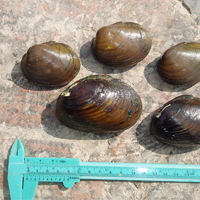Hickorynut
Scientific name: Obovaria olivaria



Cover photos credit: Dave Zanatta (all photos)
Status
Endangered
"Endangered" means the species lives in the wild in Ontario but is facing imminent extinction or extirpation.
Date added to the Species at Risk in Ontario List
January 13, 2012
Read the Assessment Report
What it looks like
The Hickorynut is a freshwater mussel with a shell that is usually less than 75 millimetres long.
It has a small, nearly oval hinged shell, ranging from green to yellowish brown, and becoming dark brown in old individuals.
Thin greenish rays are often present in young mussels.
Where it lives
Hickorynuts live on the sandy beds in large, wide, deep rivers – usually more than two or three metres deep – with a moderate to strong current.
Mussels filter water to find food, such as bacteria and algae.
Mussel larvae must attach to a fish, called a host, where they consume nutrients from the fish body until they transform into juvenile mussels and then drop off.
In Canada, the fish host of the Hickorynut is the Lake Sturgeon.
Presence of the fish host is one of the key features determining whether a body of water can support a healthy Hickorynut population
Where it’s been found in Ontario
The Hickorynut is found within the Great Lakes – St. Lawrence basin and the Mississippi River basin.
In Canada, the Hickorynut is found in sporadic locations within the Great Lakes and St. Lawrence basin, from Lake Huron to Quebec City.
In Ontario, it is found in the Mississagi River and the Ottawa River.
What threatens it
Many of the large-river habitats of the Hickorynut have been damaged by Zebra Mussel infestations, dams, or pollution caused by some industrial and agricultural activities.
Action we are taking
Endangered Species and their general habitat are automatically protected
Habitat protection
General Habitat Protection - January 13, 2012
What you can do
Report a Sighting
- Report a sighting of an endangered animal or plant to the Natural Heritage Information Centre. Photographs with specific locations or mapping coordinates are always helpful.
Volunteer
- Volunteer with your local nature club or provincial park to participate in surveys or stewardship work focused on species at risk.
Be a good steward
- Private land owners have a very important role to play in species recovery. If you find Hickorynut in a watercourse on or adjacent to your property, you may be eligible for stewardship programs that support the protection and recovery of species at risk and their habitats.
- Invasive species seriously threaten many of Ontario’s species at risk. To learn what you can do to help reduce the threat of invasive species, visit:
www.ontario.ca/invasivespecies.
www.invadingspecies.com.
www.ontarioinvasiveplants.ca.
www.dfo-mpo.gc.ca/science/enviro/ais-eae/index-eng.htm.
Report illegal activity
- Report any illegal activity related to plants and wildlife to 1-877-TIPS-MNR (847-7667).
Quick facts
- Hickorynut shells were considered valuable for the pearl button industry in the early 20th century, and were harvested for these purposes in the United States.
- Hickorynuts live from seven to 14 years. A mussel’s age can be estimated by counting the rings that form on its shell each winter when growth slows or stops – similar to the rings on a tree.
- Like many mussels, the Hickorynut has a specialized larval stage that is parasitic on fish. Larvae hitch a ride on the fish, living in cysts on the fish’s skin until they grow and drop off as adults. The fish are not harmed by their mussel hitchhikers.